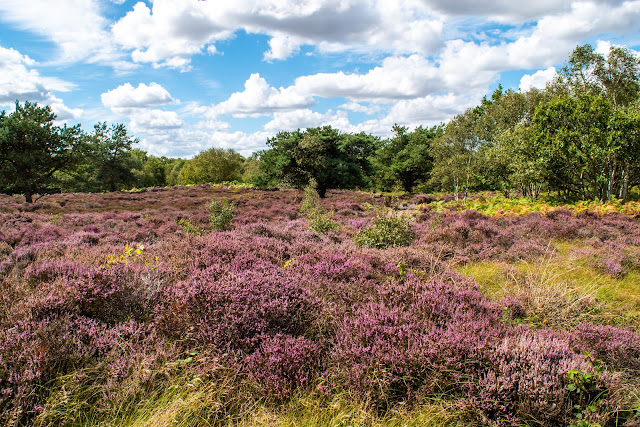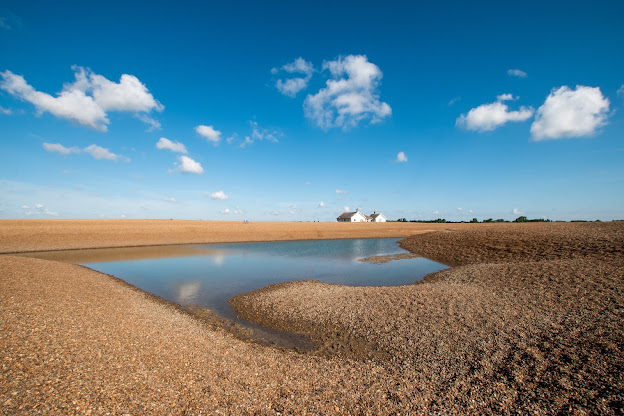As its name suggests, Shingle Street consists of a large swathe of shingle - no sand here! Where the tide has ebbed and flowed over the years, there are mounds of shingle and inlets and pools that fill and empty with the tide. It is a photographer's paradise.
It is here that local Professional Photographer, Gill Moon, held a morning coaching session, and to which we attended. I came away with several images (hopefully better than they would have been!) and I will share some in this blog. The morning started cloudless, but soon clouds started to bubble up, which was much to my delight as I love big skies and bubbling clouds. So first, some images at the area near the cottages with piles of shingle and some inlets. I was using, as an experiment, a 10-20mm Sigma lens, and this gave me huge skies.
Curves and mounds
More Curves and clouds ....
... which are starting to build
Low down view of the Coastguard cottages
Clouds gathering over the Coastguard Cottages and The German Ocean Mansion
Some searching on the internet gave a few clues as to the history of this building - but not a lot! Here is what I have: German Ocean Mansion is the long and low building on the left, and was built in 1874 as a lodging house. This name was changed during WWI, when anything German was unfashionable. In 1881 it was listed as being four dwellings. Three were unoccupied.
Living in the fourth were Benjamin and Hannah Curtis and their children Annie aged 10, Amy 8, Kate 6, Alfred 3 and Samuel 10 months. Benjamin Curtis worked for the Fonnereau family, of Christchurch Mansion, Ipswich. He was Master of their ocean-going yacht, while Hannah was listed in the 1871 Census as having been gatekeeper at Christchurch Mansion, where the family lived in the Lodge. 'German Ocean Mansion' was in the latter part of the 19th century the summer residence of the Fonnereau, and it is possible that Benjamin Curtis's presence was connected with converting the building to a single dwelling. Benjamin Curtis is listed in the 1891 Census as 'Caretaker of a house' at Shingle Street, Presumably this was German Ocean Mansion and he had retired from the sea.
After the conversion, if that is what happened, the understanding is that the north end of the house was for the Fonnereau live-in servants. Next came the living/dining area, with the family bedrooms on the south side of the central entrance.
By the late 1890s 'German Ocean Mansion' was owned by the Wellesley Colley family one of whom, Lucy, compiled a book of reminiscences by a variety of people who had lived in or visited it during the time that it was owned by her family.
Richard Clarke, Station Officer at HM Coastguard Station, Shingle Street, has kindly obtained the following information from local residents.
• The building has been known as 'The Long Summer Residence'.
• Coast Guard Officers were stationed there during both world wars.
• The building has been used as a base for exercising racehorses.
• It was known as 'The Battery' at some time, possibly in connection with the large gun which was situated at the rear of the building during WWI
In Ordnance Survey maps dated 1881 and 1889 it is marked 'Coastguard Station', although by that time it belonged to the Fonnereau, so this may have been brought forward.

Another view of the German Ocean Mansion
Now for a `Heartwarming` story:
A long line of white shells on a beach started by two childhood friends while reflecting on their cancer treatment is still going strong after 13 years.
Lida Kindersley and Els Bottema, both 64, began the shell line at Shingle Street in 2005.
It now stretches for more than 275m (300yds) and is made up of 20,000 individual whelk shells. Mrs Kindersley said it was a "symbol of friendship".
The women, who grew up together in Delft in the Netherlands, were diagnosed with breast cancer within two months of each other.
During a phone call discussing their treatment, Mrs Kindersley - a letter cutter in Cambridge - suggested to Ms Bottema - a ceramicist in Zutphen - that they meet in England, and so they travelled together to the Suffolk coast.
They said the creation of the line, which started after a long walk and chat on the beach, became part of their own, personal, therapy.
Mother-of-three Mrs Kindersley said they made a vow to return to the beach every six months to mend the line - and found others had added to it.
She said: "When we received our cancer diagnoses and the prognosis was not good, I said to Els, 'If we survive this, we will go together to Shingle Street as it is a healing place'.
"It is a symbol of friendship and togetherness, a collaboration we wanted to record before it eventually disperses."
Both women are now cancer-free.
Shingle Street resident Tim Miller said the line had become an important local feature that enhanced the wild landscape.
"Despite fierce weather conditions with strong winds, the line remains clear and powerful and visible throughout the year," he said. "The line for me is a signal of courage and survival."
Looking for odd items on the beach, I came across these three items, which I thought fitted the bill!
For hauling boats up that long shingle beach perhaps?, though not much used recently.
Possible, just rubbish!
Nearby was this table with a multitude of shaped stones and other objects on it.Finally, some wonderful colour on the shingle
A great place to wander and enjoy the solitude. Lots of things to photograph but a real peaceful haven to enjoy.





















































